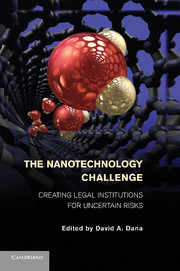Book contents
- Frontmatter
- Contents
- Contributors
- Part I Introduction
- Part II Public Perceptions of Nanotechnology Risks
- Part III Meeting the Nanotechnology Challenge by Creating New Legal Institutions
- 5 Toward Risk-Based, Adaptive Regulatory Definitions
- 6 The Missing Market Instrument
- 7 Conditional Liability Relief as an Incentive for Precautionary Study
- 8 Transnational New Governance and the International Coordination of Nanotechnology Oversight
- 9 Labeling the Little Things
- 10 Public Nuisance
- 11 Enlarging the Regulation of Shrinking Cosmetics and Sunscreens
- 12 Accelerating Regulatory Review
- 13 The Ethical Issues in Nanotechnology
- Part IV Where We Are Now – The Current Framework for Nanotechnology Regulation
- Index
- References
13 - The Ethical Issues in Nanotechnology
Persons and the Polity
Published online by Cambridge University Press: 05 December 2011
- Frontmatter
- Contents
- Contributors
- Part I Introduction
- Part II Public Perceptions of Nanotechnology Risks
- Part III Meeting the Nanotechnology Challenge by Creating New Legal Institutions
- 5 Toward Risk-Based, Adaptive Regulatory Definitions
- 6 The Missing Market Instrument
- 7 Conditional Liability Relief as an Incentive for Precautionary Study
- 8 Transnational New Governance and the International Coordination of Nanotechnology Oversight
- 9 Labeling the Little Things
- 10 Public Nuisance
- 11 Enlarging the Regulation of Shrinking Cosmetics and Sunscreens
- 12 Accelerating Regulatory Review
- 13 The Ethical Issues in Nanotechnology
- Part IV Where We Are Now – The Current Framework for Nanotechnology Regulation
- Index
- References
Summary
In 1917, as a war marked by blindingly murderous technology wound down, a curious phenomena swept Britain: a belief in spiritualism and magic, which existed directly alongside a sincere faith in science. It was a time when electrical engineering was transforming the Victorian landscape, electrifying factories for evening shift work, and linking the Empire with new, rapid, forms of communication – the technology was both mesmerizing and terrifying, threatening a physical and social order of long stable relationships of production and creation. It was a time when the breadth of the global world was fully revealed, and the Empire became linked by instant communications. The premise was that beneath the new technology, the new industrial organization, and the mystery of electrification lay a life-world within an unblemished and innocent nature that must be uniquely protected. This was signified perhaps in its purest form by the fascination with the Cottingley Fairies, fairy figures “captured” on the new media of photography, when children in the household of one of Britain's first electrical engineers took photographs they claimed as real. What is important about the Cottingley fairies was that they were widely believed, evidence of the limits of science and of the public unease and uncertainty about the “wonders” of the future. After all, the fairies seemed, in the context of the times, as neither more nor less fantastic than the idea of electrical currents coursing through the air, or across wires traversing a many miles, or of photography itself, which created narratives that were both real (in science) and set piece constructions of a photographic framer (in the case of the fairies). The father of the children who reported the fairies was part of the effort to electrify the textile factories, transforming the darkness of the north English winter night into perpetual day.
Belief in things unseen made oddly consonant bedfellows with technology. The children's photographs were not only championed by Harry Houdini, three experts from the Kodak camera company, and others who also embraced industrialization, modernity, and progress and were skeptical about fakes, but also by Sir Arthur Conan Doyle and other spiritualists who had an interest in promoting the existence of a spiritualized world and contact with ghosts. The girls’ photographs were fully and widely believed to be authentic (which seems remarkable, given what looks to our eyes to be an obvious fake) because they had not claimed to see fairies, they had the mechanical photographic proof they had seen them. Of course, faked photographs, as was demonstrated in the pages of Science in 2007 with the faked stem cell cloning photos, would become a constant feature of science hoaxes. In 1917, after a decade of scientific progress, an optimistic public was ready to believe in what the experts confirmed was true.
- Type
- Chapter
- Information
- The Nanotechnology ChallengeCreating Legal Institutions for Uncertain Risks, pp. 337 - 354Publisher: Cambridge University PressPrint publication year: 2011



